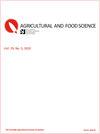第一次、第二次和第三次采草青贮对奶牛采食量和产奶量的影响
IF 1.1
4区 农林科学
Q3 AGRICULTURE, MULTIDISCIPLINARY
引用次数: 2
摘要
本研究的目的是比较北纬地区同一草地青贮一期、二期和三期的产奶量潜力。在气候条件明显不同的年份进行了3次转换设计奶牛饲养试验。本研究的目的是比较北纬地区同一草地的第一次、第二次和第三次草青贮的产奶量潜力。在气候条件明显不同的年份进行了3次转换设计奶牛饲养试验。青贮饲料中添加谷类精料(平均精料比例为431 g kg-1日粮干物质)。青贮一期采食量和产奶量最高,三期最低。3个试验一期、二期和三期青贮的能量修正产奶量平均分别为35.0、33.2和31.9 kg d-1。干物质采食量分别为23.1、21.9和20.7 kg d-1。与分析的饲料值相比,第三段青贮的平均采食量低于预期。由于三切青贮的高采食潜力低的风险,如果有其他青贮,则不建议在哺乳期早期的奶牛使用。本文章由计算机程序翻译,如有差异,请以英文原文为准。
A comparison of grass silages harvested at first, second and third cut on feed intake and milk production of dairy cows
The objective of this study was to compare the milk production potential of first, second and third harvest of grass silage from the same sward in Northern latitudes. Three change-over design dairy cow feeding experiments were conducted during different years which differed markedly in weather conditions. The silages were supplemented with a cereal based The objective of this study was to compare the milk production potential of subsequent first, second and third cuts of grass silage from the same sward in Northern latitudes. Three change-over design dairy cow feeding experiments were conducted during different years which differed markedly in weather conditions. The silages were supplemented with a cereal based concentrate (average concentrate proportion 431 g kg-1 diet dry matter). Feed intake and milk production was highest with first-cut and lowest with third-cut silage. The energy corrected milk yields averaged over three experiments were 35.0, 33.2 and 31.9 kg d-1 for first, second and third harvest silages, respectively. Respective dry matter intakes were 23.1, 21.9 and 20.7 kg d-1. Compared to analysed feed values, the average intake of third-cut silages was lower than expected. Due to the high risk of low intake potential of third-cut silages, they are not recommended for cows in early lactation if there are other silages available.
求助全文
通过发布文献求助,成功后即可免费获取论文全文。
去求助
来源期刊

Agricultural and Food Science
农林科学-农业综合
CiteScore
2.50
自引率
0.00%
发文量
22
审稿时长
>36 weeks
期刊介绍:
Agricultural and Food Science (AFSci) publishes original research reports on agriculture and food research related to primary production and which have a northern dimension. The fields within the scope of the journal include agricultural economics, agricultural engineering, animal science, environmental science, horticulture, plant and soil science and primary production-related food science. Papers covering both basic and applied research are welcome.
AFSci is published by the Scientific Agricultural Society of Finland. AFSci, former The Journal of the Scientific Agricultural Society of Finland, has been published regularly since 1928. Alongside the printed version, online publishing began in 2000. Since the year 2010 Agricultural and Food Science has only been available online as an Open Access journal, provided to the user free of charge. Full texts are available online from 1945 on.
 求助内容:
求助内容: 应助结果提醒方式:
应助结果提醒方式:


